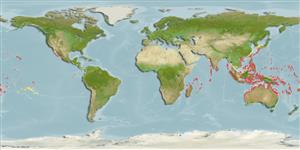>
Blenniiformes (Blennies) >
Tripterygiidae (Triplefin blennies) > Tripterygiinae
Etymology: Enneapterygius: Greek, ennea = nine times + Greek, pterygion = little fin (Ref. 45335).
More on author: Peters.
Environment: milieu / climate zone / depth range / distribution range
Écologie
marin récifal; profondeur 0 - 8 m (Ref. 27223). Tropical
Indo-Pacific.
Taille / Poids / Âge
Maturity: Lm ? range ? - ? cm
Max length : 3.0 cm SL mâle / non sexé; (Ref. 27223)
Description synthétique
Clés d'identification | Morphologie | Morphométrie
Épines dorsales (Total) : 13 - 16; Rayons mous dorsaux (Total) : 8 - 9; Épines anales: 1; Rayons mous anaux: 15 - 17. Pectoral-fin rays15, at least some branched; caudal peduncle without distinctive bar or marking; body without well defined bars; body, head and fins of males densely and evenly covered with melanophores, lower half of head generally darker than upper, in immature males and females less densely covered with melanophores sometimes showing indistinct oblique bars on body and anal fin; supratemporal sensory canal C-shaped, running in a curve in front of the first dorsal-fin spine; single symphysial mandibular pore present; no labial folds.
Adults occur in tide pools; in shallow water on beach rock, brown algae and coralline algae. Apparently associated with coralline rocky shore or reef flat (Ref. 27223). Eggs are hemispherical and covered with numerous sticky threads that anchor them in the algae on the nesting sites (Ref. 240). Larvae are planktonic which occur primarily in shallow, nearshore waters (Ref. 94114).
Life cycle and mating behavior
Maturité | Reproduction | Frai | Œufs | Fécondité | Larves
Fricke, R., 1997. Tripterygiid fishes of the western and central Pacific, with descriptions of 15 new species, including an annotated checklist of world Tripterygiidae (Teleostei). Theses Zool. 29:1-607. (Ref. 27223)
Statut dans la liste rouge de l'IUCN (Ref. 130435: Version 2024-2)
Menace pour l'homme
Harmless
Utilisations par l'homme
Pêcheries: sans intérêt
Outils
Articles particuliers
Télécharger en XML
Sources Internet
Estimates based on models
Preferred temperature (Ref.
123201): 24.6 - 29.3, mean 28.3 °C (based on 2580 cells).
Phylogenetic diversity index (Ref.
82804): PD
50 = 0.5000 [Uniqueness, from 0.5 = low to 2.0 = high].
Bayesian length-weight: a=0.00617 (0.00288 - 0.01322), b=3.04 (2.86 - 3.22), in cm total length, based on LWR estimates for this (Sub)family-body shape (Ref.
93245).
Niveau trophique (Ref.
69278): 3.1 ±0.3 se; based on size and trophs of closest relatives
Résilience (Ref.
120179): Haut, temps minimum de doublement de population inférieur à 15 mois (Preliminary K or Fecundity.).
Fishing Vulnerability (Ref.
59153): Low vulnerability (10 of 100).
Nutrients (Ref.
124155): Calcium = 634 [211, 3,017] mg/100g; Iron = 2.99 [0.90, 7.48] mg/100g; Protein = 18.2 [16.3, 20.1] %; Omega3 = 0.0937 [, ] g/100g; Selenium = 65.3 [10.1, 327.3] μg/100g; VitaminA = 34 [4, 305] μg/100g; Zinc = 6.76 [2.64, 13.74] mg/100g (wet weight);
